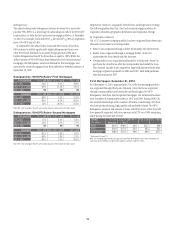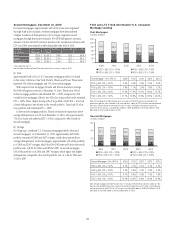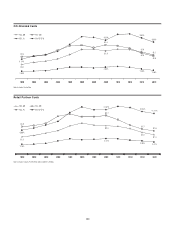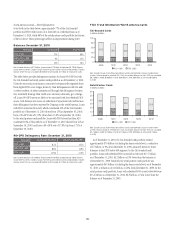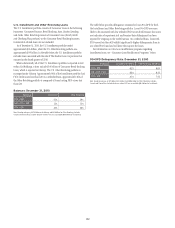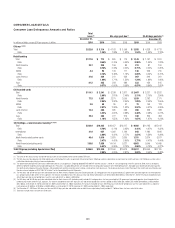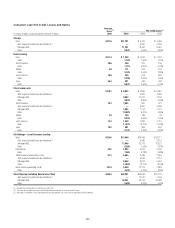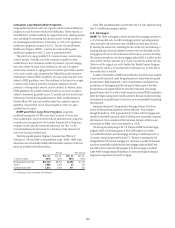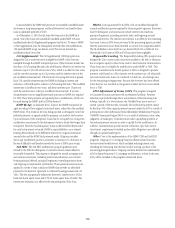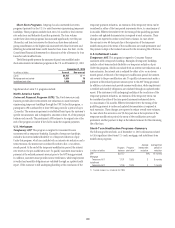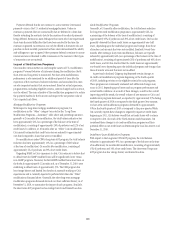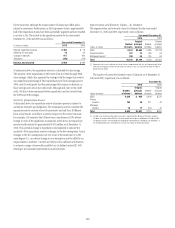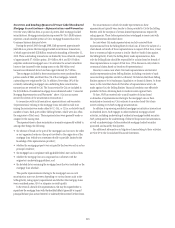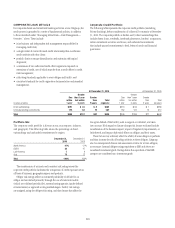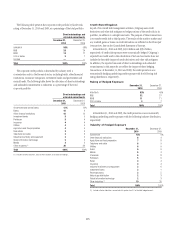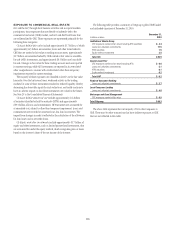Citibank 2010 Annual Report Download - page 108
Download and view the complete annual report
Please find page 108 of the 2010 Citibank annual report below. You can navigate through the pages in the report by either clicking on the pages listed below, or by using the keyword search tool below to find specific information within the annual report.106
Loans included in the HAMP trial period are not classified as modified under
short-term or long-term programs, and the allowance for loan losses for these
loans is calculated under ASC 450-20.
As of December 31, 2010, for the loans that were put in the HAMP trial
period, 34% of the loans were successfully modified under HAMP, 13% were
modified under the Citi Supplemental program (see below), 5% were in HAMP
or Citi Supplemental trial, 2% subsequently received other Citi modifications,
13% received HAMP re-age (see below), and 33% have not received any
modification from Citi to date.
Citi Supplemental. The Citi Supplemental (CSM) program was
designed by Citi to assist borrowers ineligible for HAMP or who become
ineligible through the HAMP trial period process. If the borrower already has
less than a 31% housing debt ratio, the modification offered is an interest rate
reduction (up to 2.5% with a floor rate of 4%), which is in effect for two years,
and the rate then increases up to 1% per year until the interest rate is at the
pre-modified contractual rate. If the borrower’s housing debt ratio is greater
than 31%, specific treatment steps for HAMP, including an interest rate
reduction, will be followed to achieve a 31% housing debt ratio. The modified
interest rate is in effect for two years, and then increases up to 1% per year
until the interest rate is at the pre-modified contractual rate. If income
documentation was not supplied previously pursuant to HAMP, it is required
for CSM. Three trial payments are required prior to modification, which can
be made during the HAMP and/or CSM trial period.
HAMP Re-Age. As disclosed above, loans in the HAMP trial period are
aged according to their original contractual terms, rather than the modified
HAMP terms. This results in the loan being reported as delinquent even if the
reduced payments, as agreed under the program, are made by the borrower.
Upon conclusion of the trial period, loans that do not qualify for a long-term
modification are returned to the delinquency status in which they began their
trial period. However, that delinquency status would be further deteriorated
for each trial payment not made. HAMP re-age establishes a non-interest-
bearing deferral based on the difference between the original contractual
amounts due and the HAMP trial payments made. Citigroup considers
this re-age and deferral process to constitute a concession to a borrower in
financial difficulty and therefore records the loans as TDRs upon re-age.
2nd FDIC. The 2nd FDIC modification program guidelines were
created by the FDIC for delinquent or current borrowers where default is
reasonably foreseeable. The program is designed for second mortgages and
uses various concessions, including interest rate reductions, non-interest-
bearing principal deferral, principal forgiveness, extending maturity dates,
and forgiving accrued interest and late fees. These potential concessions are
applied in a series of steps (similar to HAMP) that provides an affordable
payment to the borrower (generally a combined housing payment ratio of
42%). The first step generally reduces the borrower’s interest rate to 2% for
fixed-rate home equity loans and 0.5% for home equity lines of credit. The
interest rate reduction is in effect for the remaining term of the loan.
FHA/VA. Loans guaranteed by the FHA or VA are modified through the
normal modification process required by those respective agencies. Borrowers
must be delinquent, and concessions include interest rate reductions,
principal forgiveness, extending maturity dates, and forgiving accrued
interest and late fees. The interest rate reduction is in effect for the remaining
loan term. Losses on FHA loans are borne by the sponsoring agency, provided
that the insurance has not been breached as a result of an origination defect.
The VA establishes a loan-level loss cap, beyond which Citi is liable for loss.
Historically, Citi’s losses on FHA and VA loans have been negligible.
Responsible Lending. The Responsible Lending (RL) program was
designed by Citi to assist current borrowers unlikely to be able to refinance
due to negative equity in their home and/or other borrower characteristics.
These loans are not eligible for modification under HAMP or CSM. This
program, launched in the fourth quarter of 2010, is designed to provide
payment relief based on a floor interest rate by product type. All adjustable
rate and interest only loans are converted to fixed rate, amortizing loans
for the remaining mortgage term. Because the borrower has been offered
terms that are not available in the general market, the loan is accounted
for as a TDR.
CFNA Adjustment of Terms (AOT). This program is targeted
to Consumer Finance customers with a permanent hardship. Payment
reduction is provided through the re-amortization of the remaining loan
balance, typically at a lower interest rate. Modified loan tenors may not
exceed a period of 480 months. Generally, the rescheduled payment cannot
be less than 50% of the original payment amount unless the AOT is a result of
participation in the CitiFinancial Home Affordability Modification Program
(CHAMP) (terminated August 2010) or as a result of settlement, court order,
judgment, or bankruptcy. Customers must make a qualifying payment at
the reduced payment amount in order to qualify for the modification. In
addition, customers must provide income verification (pay stubs and/or
tax returns), employment is verified and monthly obligations are validated
through an updated credit report.
Other. Prior to the implementation of the HAMP, CSM and 2nd FDIC
programs, Citigroup’s U.S. mortgage business offered certain borrowers
various tailored modifications, which included reducing interest rates,
extending the remaining loan duration and/or waiving a portion of the
remaining principal balance. Citigroup currently believes that substantially
all of its future long-term U.S. mortgage modifications, at least in the near
term, will be included in the programs mentioned above.


